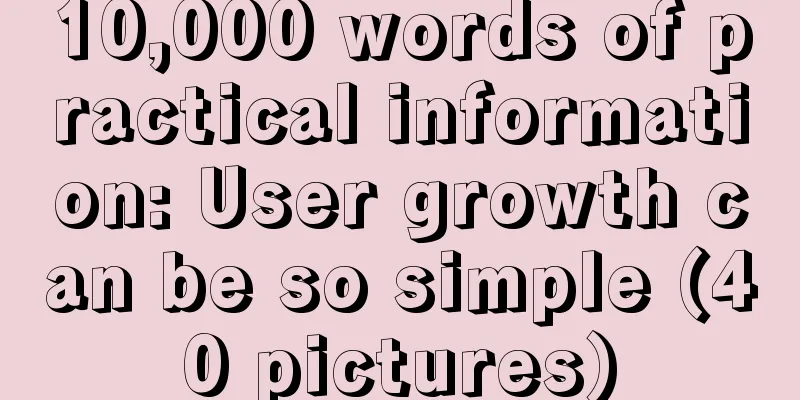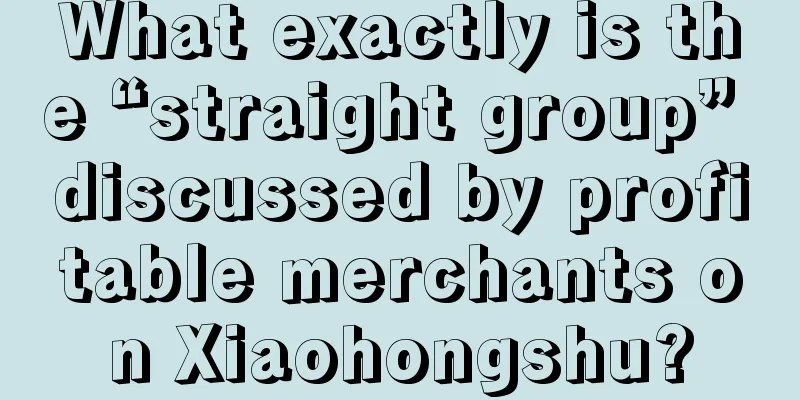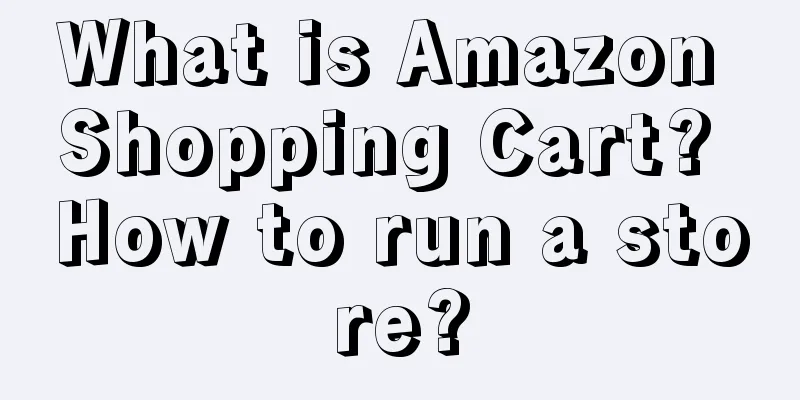10,000 words of practical information: User growth can be so simple (40 pictures)

1. What is growth?We all learned this math problem in elementary school: If the water inlet of a pool is opened for X hours and the water outlet is opened for Y hours, how many hours will it take to fill the pool if both the inlet and outlet are opened at the same time? This is also very relevant when applied to products and companies. If there are X new users and Y lost users every day, how long will it take to reach 10 million net new users? Back to the question itself, growth can be understood as continuously expanding new customers and new channels to increase X, continuously improving user retention rate (online time, activity, etc.) and reducing Y value. The value of XY becomes larger and larger to better cope with the impact of many changes from market/environment/technology/culture, while improving its risk resistance, competitiveness and commercialization capabilities. 2. Why is there so much talk about growth?The topic of growth has always existed, but in the early years, the number of domestic Internet users has been growing rapidly, and everyone has been quietly conquering cities and harvesting users. Even if someone talks about the topic of growth, it is only a small-scale discussion. As mentioned at the beginning, the demographic dividend is disappearing and the price of acquiring customers has increased, so everyone has paid more and more attention to the topic of growth. It used to be easy to increase sales by over 10,000 per day, but now it is extremely difficult. Also, the previous growth methods are no longer effective or the cost-effectiveness has decreased, and users have all gone to direct or indirect competitors. At this time, companies will have a stronger demand for growth, and the entire industry will become anxious about growth. 3. Growth mindset value is constantWhen it comes to growth, many people will think of growth hackers, AARRR model, North Star indicators, growth models, AB testing, data embedding, funnel models, and of course the most intuitive and bold way to buy traffic and advertise. You have heard of or understood some of these terms or concepts, but is it enough to understand or master them? It is said that it is better to teach a man to fish than to give him a fish. The above concepts or methods of growth will change greatly with the changes in the environment, technology and society. I hope to summarize some growth methodologies or growth thinking that will not become outdated with the passage of time. 4. The origin of all things is simpleMany people may think that growth is difficult and complicated, but in fact, "the beginning of all things is simple." Let's go back to the example of the reservoir at the beginning of the article. Combining this example, we can find that growth is simply to make X infinitely larger and Y infinitely smaller. But some people may say, I understand the principle, then what? In fact, whether it is product or operation, a very important skill is to learn how to decompose tasks or indicators. The same is true for growth or X/Y. We need to enumerate all possible ways or methods to increase X as much as possible, forming X1/X2/X3..., and then analyze the key nodes that affect X1. The same goes for Y value. Doing Big X can be simplified as: increasing the number of channels. This is easy to understand. You can't put all your eggs in one basket, and of course, you can't put the basket in one car. You have to add multiple water inlets to the pool (or water pipes if that doesn't work). In other words, you have to have multiple customer acquisition channels. The Y value can also enumerate all its ways and methods, and then it can be simplified into two things: improve conversion rate and reduce churn rate . These three simple sentences with only 16 words reveal the essence of growth thinking. 5. Increase the number of channels: the more the betterBe prepared for danger in times of peace. No company or product can be satisfied with the current customer acquisition channels. They need to maintain a high sense of crisis at all times. They need to actively find and try new channels while using existing channels, and be ready to rebuild their own traffic and customer acquisition structure at any time to ensure that their new customer acquisition is sustainable. For example, users who have been online or playing games for a long time should know that World of Warcraft was first operated by The9 in mainland China, and more than 95% of The9's revenue was also dependent on the game. Later, the game operation rights of World of Warcraft were handed over to NetEase, and The9 became a memory of the Internet, and there was no more. Let's take a more recent example. More than half of the users of Qudian, an Internet finance company, came from Alipay. However, after the contract between the two parties expired, the cooperation was terminated. The number of users and revenue of the company plummeted and the business was bleak. So my former employer, Mashang Finance, held an internal special meeting called "How to expand and strengthen self-operated products (channels)". At present, the traffic channels in the market are basically divided into the following categories:
These may become traffic entrances and customer acquisition channels. I will explain these channels below to give you a deeper understanding. Some channels may not be as bad as you think, and may even subvert or exceed your cognition. Then you can choose the traffic entrance that matches your product scenario and capabilities according to the specific situation of your business. 5.1 Natural traffic acquisitionIn the past PC Internet era, search engines were an important mainstream traffic channel, and Baidu and Google were the representatives of that era. Looking at their financial reports, you can find that advertising marketing accounts for a high proportion. In this era of mobile Internet and new media, Taobao, Ctrip and other platforms have taken a lot of vertical search traffic, and then platforms such as Weibo and Douyin have taken away part of the traffic. Search represented by Baidu is not as important as before, but even so, search engine marketing is still worth doing. What you may not know is that among search engines, more than 65% of traffic comes from mobile terminals, so don’t think that search engines represent PC traffic. Baidu’s DAU has not decreased, it’s just that search has shifted from PC to mobile phones. And you have to remember: the traffic conversion rate of search engines has always been the highest among all traffic channels. This is because the traffic nature of vertical apps such as Taobao and Weibo is “browsing”, while search engine traffic is active “searching”. Search engine traffic can have a high conversion rate when keywords and content match. Secondly, search engine traffic is relatively stable and controllable, and traffic like SEO natural rankings does not cost money, so you can see that many companies and products attach great importance to this. If you are interested, you can find a few products and websites and check them on aizhan.com. However, there are still many companies and products that do not realize the importance of search engine traffic and SEO. They spend money on traffic and advertising, but do not cultivate the free and long-term customer acquisition channels of search and SEO. They are simply picking up sesame seeds and losing watermelons. Let me tell you two data to let you know how important this is. In the early days of iCIBA, search engines could contribute nearly 70% of the traffic. Zhihu had more than 40 million daily UVs at a certain time, and search engines contributed more than 30%. In the next 5-10 years or even longer, search and SEO will still be a very good free customer acquisition channel, without a doubt. As for how to do this channel well, there is too much to say, and I will not expand here due to space limitations. Those who are interested can study it themselves. 5.2 APP Application MarketWhether it is the early PC era or the current APP era, the conventional path for most users to obtain applications is basically to search first, and then identify the desired results in the search results. In the PC era, software was downloaded through download pages (sites), and in the APP era, APP downloads and installations are completed in the application market. In the PC era, there are software products such as Tianji.com, Pacific Download, 17173, Duowan Games, Tencent Games, Sina Games, 360 Software Manager, Tencent Software Manager and other download sites and application distribution channels. In the APP era, there are Wandoujia, Yingyongbao and the application markets of various mobile phone brands for application and traffic distribution. WeChat mini-programs have been very popular in recent years. Some lightweight application users choose to use mini-programs instead of installing apps. As the leading platform for mini-programs (Alipay and Baidu are also developing platforms similar to mini-programs, and leading mobile phone manufacturers have also launched the Quick App Alliance), WeChat has seriously threatened the iOS application market, that is, Apple's status in the market. After all, controlling the traffic distribution market means having higher pricing power. There are not many options in the iOS app market, but there are too many to choose from in the Android channel. The abundance of channels provides manufacturers with choices, but it also increases the difficulty of choosing. Which channels are in line with their own products, which ones should be focused on, and which ones only need to be treated normally, all require constant trial and error. The PC search era created a term called SEO, and the APP application market was also accompanied by the birth of a new term, which is ASO. The relevant introduction of ASO will not be elaborated here. Students who are interested can still learn about it by themselves. Some students may have discovered a problem. With the birth of new trends and new industries, there will always be some new things derived. For example, SEO and search, ASO and APP market, SEO and ASO can be understood as the advanced "productivity" corresponding to these two eras. You have to understand the working principles and mechanisms behind these two productivity, and then take positive countermeasures, rather than miss the opportunity. 5.3 Alipay Service WindowService Window is a service platform provided by Alipay for enterprises, organizations and individuals to directly connect with users. Merchants can use this platform to push information activities to users, open up transaction scenarios and manage member services. The platform was launched for internal testing in May 2014, nearly two years later than WeChat's official account, which was launched in August 2012. People who know about the service window basically know about the official account, but those who know about the official account may not know about the service window. Most people who have heard of it may think that the service window is ordinary and there is no need to talk about it separately. I myself did not know about such a channel before 2018, but what I want to say is that the service window may not be as simple as everyone imagines. As shown in the figure below, search for the application name or any keyword in the search box at the top of the Alipay homepage, and then you can enter the application list. Select the corresponding application from the list to enter the details page. In the upper right corner of the details page, you can add it to the homepage of the Alipay APP, which will be more convenient for you to query and use it next time. Let me take a financial company as an example. The company has many channels for acquiring customers, and Alipay service window is one of them. But do you know which channel contributes the most loan orders (which can be understood as orders) and loan amounts: Alipay, WeChat applet, WeChat public account, or self-operated APP (there are 4)? Some people may think that the example I gave in this chapter should be the Alipay service window. Even if you guessed it right, do you know how high it is? The answer is higher than the sum of the number of orders and loan amounts from all other channels. When I learned this information, I was as shocked as everyone else. And the overall quality of customers brought by the service window is also the highest. As of the time I wrote this article, there are still many companies that do not know about the Alipay Service Window channel, what kind of services and capabilities this channel can provide, what kind of products are suitable for acquiring customers through this channel, what is the conversion rate of this channel, what is the retention rate, and what is the user quality. Through this example, I want to make a point: you need to have a relatively in-depth understanding of all the channels on the market, don't take it for granted, and don't take it lightly. In particular, you must pay close attention to the various platforms and channels provided by large companies and try them out early. In the early years, you could make it on Weibo and public accounts with a little effort, but now it will be particularly difficult for you to become a leader because you have missed the window bonus period of these channels and platforms. 5.4 WeChat Mini Programs and Official AccountsAPP can be used as a carrier of the overall product ecosystem, accumulate loyal users, provide full-process and full-capability services, and is the best carrier for realizing commercial value. Manufacturers all want to install their own APP on users' mobile phones, so everyone has their own unique ways. Some manufacturers directly pre-install APP when the mobile phone leaves the factory, winning at the starting line. WeChat public accounts can serve as a distribution center for manufacturers or products in the WeChat ecosystem, a portal for them to publish information in WeChat, a window for users to understand merchants, and a function for merchants to distribute traffic in WeChat. In some scenarios, you can also set the path for them to transform into mini programs and apps. WeChat Mini Program is one of the important scenarios for converting users in the WeChat ecosystem, and it has a certain convenient window for sharing. However, Mini Program is not a traditional channel. When planning Mini Program, you need to consider clearly: how to create scenarios that meet user interests, can be fissioned, and use acquaintances to share? Are there any traffic channels that have been built around these scenarios? If there are, continue to strengthen and optimize. If not, you need to build such scenarios. At worst, you can make a position to prevent other counterfeit manufacturers from taking advantage of you. APPs are more expensive to use and have a longer usage path, while public accounts focus more on services. Mini programs can be in between and provide lighter and better services. Moreover, the mini program cards shared to WeChat groups or friends through mini program fission activities are more attractive than the text + link format of H5. At the same time, WeChat authorization can be obtained, and the conversion path is shorter. APP, mini-programs and official accounts are all important terminal channels for obtaining traffic and customers, and they can direct traffic to each other, that is, mini-programs and official accounts can "deliver" users to APP and achieve APP customer acquisition. There are two good ways to acquire customers in public accounts, namely: natural traffic acquisition and public account matrix acquisition. The former can be regarded as a subdivision of "5.1 natural traffic acquisition", and the latter, if strictly speaking, should also be regarded as the category of natural traffic acquisition. We will not dwell on it too much here and directly post the case. Natural traffic acquisition: refers to the way users acquire customers by following the public account in the search results after searching for keywords or brand/product names in WeChat. As shown in the left picture below, users with unclear goals search for the public account through specific keywords such as "borrowing, loan, borrowing money", and users with clear goals search through product, company or brand names, such as "An Yi Hua", and then select from the search results and follow it to learn more. Public account matrix: Different users have different search preferences when searching. In order to better and more comprehensively hit the most popular keywords with more searches, the public account matrix is currently a common method used by the industry and competitors. The public account matrix can achieve business segmentation, content grouping, and customer grouping based on the different names and positioning of the public accounts, thereby achieving differentiated and refined operations. The following is the public account matrix of CMB, each public account has a different positioning and covers different customer groups. The matrix strategy is not only applicable to public accounts, but also to WeChat applets, Alipay service windows, and Weibo. CMB has currently opened 7 service windows on Alipay to achieve a matrix layout, and Xiaomi has opened countless matrix Weibo accounts on Weibo. 5.5 Channel classification management strategyThere are many channels on the market, and the above are just some of them. There are many other channels such as Weibo, Douyin, Kuaishou, Xiaohongshu, Toutiao, Dayu, Baijiahao, iQiyi, etc. Enterprises or products should try as many channels as possible according to their actual situation, and then ensure that they have one or more core channels. For customers attracted by various channels of the enterprise, it is necessary to establish a tracking mechanism (registration, consumption/contribution) to comprehensively evaluate their activity, contribution, etc., so as to implement a channel classification management strategy, so as to find high-quality channels for continuous investment, discover potential channels for key exploration, and identify junk channels and abandon them in time to stop losses. Of course, the criteria for channel division are dynamic and changing. Today's high-quality channels may become mixed channels after three to five months, and the users of the channel may be harvested. At this time, a conversion strategy is needed. For example, a financial company initially placed advertisements on Tencent Video and found that all indicators were good. Later, various competing products also actively entered the market to divide customers. After half a year, the channel was left with only a mess, and everyone had to give up. Some students may wonder why you didn’t introduce the common traffic purchase and advertising? This question is actually very simple. Most of the above channels are free. Everything has its priorities. I personally think that you can first acquire customers through these free channels, verify the product process and business model, and then spend money to quickly gain customers. 6. Improve conversion rateThe conversion rate in this chapter is divided into two parts, namely external conversion rate and internal conversion rate. Users see an ad or promotion and enter the conversion page, then download and install the APP from the conversion page (or jump to the app store), and then open the APP. We can call all the links before opening the APP external conversion rate. All the links and processes after opening the APP, because the user is already inside the APP, in order to distinguish it from the previous conversion rate, I will call the conversion rate within the APP the internal conversion rate. 6.1 External Conversion RateIn most cases, the traffic from the various channels mentioned above will not go directly to the APP or software download page, but to a landing page, which is translated into Chinese as a landing page or landing page. The purpose of the landing page is to tell users more about the product and let them get your UPS (unique selling point). When explaining the value of your product, you need to let users know in a short time how your product can help them solve problems and what concrete value it can bring. Therefore, the copy on the landing page should clearly tell users why they should continue to click or register here, and then clearly explain the problems that can be solved and the solutions, in order to achieve the purpose of improving conversion rate. Some people may ask, why not jump directly to the app store or download page or install directly? Then ask yourself, when you are surfing the Internet, you accidentally click on a pop-up window or bubble, and then the system directly installs an app for you. Would you panic? Can you tolerate this installation operation? Even a rogue like Baidu would not do such a thing. Let’s get back to the point. No matter how you get users to click, they will enter the landing page. So the question is: how can you use this landing page to impress users and promote conversions within a limited area and time? In simple terms, there are 8 key points, and each point can be written into a paper of several hundred pages. Due to the limited space, I will select one point to explain. Here we will choose the point of "trust". Regarding trust, brand guru Trout actually provides 7 practices. I will explain them with some common cases in real life.
Landing pages and A/B testing work best together. In order for the test results to be useful, A/B testing should only test one variable (change) per experiment. If an experiment tests multiple variables (such as price and color), we don’t know which variable contributed to the improvement. To better illustrate A/B testing, the following example is used. This example is generally used in the environment of internal conversion rate and reducing churn rate. It is used here for the purpose of illustration. Please do not take it too seriously. For the following five test scenarios, the control group B does nothing without sending text messages, and the text messages of A1-A4 are emphasized in the copywriting. The results take the control group B as the baseline value of 0, and the regression rates of A1/A2/A3/A4 are 5/3/7/5 percentage points respectively. It can be seen that the effect of group A3 is the best and the effect of group A2 is the worst. It can be seen that sending text messages is definitely better than not sending them. 6.2 Internal Conversion RateBefore talking about internal conversion rate, we need to explain another issue first: the North Star indicator. Growth cannot be avoided by the "North Star Indicator", but what should this North Star indicator be in the application? Is it the number of daily new users or the number of daily active users? These two data are undoubtedly very important and are often used as product KPIs. However, the increase in the number of daily new users or daily active users does not mean that the customer is growing effectively. The increase in new users may be short-lived. For example, Luo Yonghao's Chatbot, relying on Luo Yonghao's KOL aura and user sentiment, has topped the list of daily new users for half a month, but now it is in a bleak situation. What about daily active users? Facebook uses it as its North Star indicator, which seems to be a good North Star indicator, but is it suitable for our company or product? Before answering this question, you need to first confirm what the business model of the business or enterprise you are responsible for is. For example, for an e-commerce company or product, the North Star goal is revenue (this also applies to gaming products), revenue = users * conversion rate * ARPU , please remember this formula, the following will break down these three indicators one by one. After building a model around revenue, or more precisely, splitting the formula, we need to improve the breakthrough item by item according to each split factor (of course, this formula can be broken down further), improve each factor in the formula, and then we need to start building a growth model, determine the core indicators, and find auxiliary indicators and reverse indicators. Being a user means activation and retention: We have introduced customers into our APP product system through the customer acquisition methods described in Chapter 5, and have continuously expanded the user base. Then we divide the life cycle of these users into two stages: the new user stage and the old user stage. We have different ways to activate and retain new and old users. Activation of new users: In the first few days after a customer enters the product system, we need to guide the user to discover the value of the product and generate subsequent behavioral operations. Relevant theoretical research has found that compared with lost users, retained users will have some key behaviors and actions to complete activation, which is the Aha moment in the figure above. These users are more likely to be retained than other users. These behaviors correspond to a concept: magic number. The magic number for Twitter is to follow 5-10 more users on the first use, Facebook is to add 7 friends within 10 days, Linkedin is to add 5 friends within a week, and Dropbox is to use Dropbox once. When I was working on the Window of Knowledge APP (which can be understood as Toutiao in the education field in 2012), I subconsciously practiced the above theory. When users install this APP, we will give them a few default channels to follow. Later, we found that after this adjustment, the activation and retention indicators of the APP improved significantly. You can also compare Zhihu to see whether it also asks you to follow some topics or channels when you use it for the first time, so as to achieve the purpose of Aah moment. There are actually some rules to follow when activating new users. We can extract the behavior of activating users into a formula (as shown below). We need to increase motivation, reduce resistance, and increase rewards to achieve the goal of better activation. The above may be a bit abstract, so let's give an example. For example, in the step of "reducing resistance", we need to list every step of the user path, and then see how to streamline and optimize it. The path process of financial products is particularly long, and there is a lot of room for improvement in this link. Entrance -> H5 landing page (loading) -> Share entrance registration -> Application -> Authentication & liveness recognition -> Credit -> Borrowing -> Withdrawal -> Repayment -> Reborrowing. The reasons for user retention at different stages are different. The following is a brief summary of the reasons for loss of game products at various stages (if you do it well, you can retain users). We propose targeted solutions to these reasons, and then continuously adjust and optimize through A/B testing to improve the retention rate at each stage and expand the user base. An authoritative organization specializing in IT project tracking once conducted research on many large organizations and found that every company and every team can produce many functions, but in most products, 50% of the functions are basically not used by users, 30% of the functions are rarely used, and 20% of the functions are frequently used by users. Instead of adding more features, we should think about which features can better retain users. If retention is the biggest core indicator, then breaking it down into product features means improving the retention of a single feature. What product managers need to do is to take inventory of all the features of their products and establish a product feature retention matrix. Imagination is beautiful but reality is cruel. For users who are about to churn or have already churned, we need to face it calmly and reposition them to better recall users. So: how long is considered churn? The following is a simple definition of the churn time of different types of products. In fact, we can also develop a set of monitoring indicators for products to identify and warn of churn. We have talked a lot about user retention and activation above. In fact, there is another way to expand the user base, which is to use the sharing fission invitation mechanism to acquire new users. In the early days of online games, we called it the promoter system, that is, existing old customers use identity identification codes to invite new customers to join the product, and old customers can return commissions in proportion to the new customers' consumption in the system. The promoter system has played an important role in the history of domestic Internet. It still exists today, but it has changed its name. Some call it the old-to-new system, and some call it the MGM system, but the essential principles are the same. It’s just that now it is combined with H5/mini programs and other carriers to play more diverse ways. Throughout the entire Internet industry, almost all large and small companies are using this MGM mechanism. From my experience in MGM, this mechanism has extremely low cost (much lower than the cost of advertising to acquire customers) and is extremely cost-effective. My former colleague even wrote a long article of more than 10,000 words to introduce the MGM system, but I will not elaborate on it here due to space limitations. Improve the conversion rate of each process. The premise for shortening the conversion or purchase path is that we need to sort out the user's action path, and then determine the difference between the user's actual path within the product and the main path expected by the product, while determining the user's actual mainstream path and discovering some paths that were not known in advance. Take the order process of a shopping mall app as an example. The end point is the shopping cart. What are the user behavior paths and which one is the most mainstream? We can try to enumerate it like this:
……. Then analyze the data and find clues. Among the N paths above, you can statistically analyze the funnel conversion rate of each path, and then propose N solutions for certain links with low conversion rates. Perform A/B tests on these N solutions to find the full update that has the most obvious conversion rate improvement, and repeat this process. For example, in path 6, we found that the conversion rate of "repurchase -> add to cart" is very low, so we need to analyze why it is low. There may be the following reasons:
Then we combined the theory of A/B testing to create four test control groups, and then monitored the various indicators and data of each control group to find the optimal solution. Let's take the problem a step further. The user path in financial products is very long. The core process is "application->authentication & liveness recognition->credit->loan->withdrawal". If it is further divided into pages and elements, it will be even longer. Due to the particularity of the business, this process cannot be streamlined. What should we do? As long as the mindset does not slip, there are always more solutions than difficulties. We know that Taobao has a very cool thing called "Thousands of Faces for Thousands of People". In fact, our products can also learn from this practice. Provide different homepages or module content for customers at different stages (newcomers, old users, tourists). As shown in the figure below, new and old customers see different homepage content. Even if they are both new users, their user journeys will also see different content. The specific implementation logic and rules here are relatively complicated, so I will not expand on them here. Improve ARPU value: Let's take an example to explain how to increase ARPU. The common practice and routine in e-commerce is free shipping for orders over 200 yuan, 30 yuan discount coupon for orders over 300 yuan, and 60 yuan cash discount for orders over 500 yuan. So how to increase ARPU in financial products? In fact, it is similar in nature, giving users a higher goal or anchor point. As shown in the figure below, the user now has a credit limit of 20,000 yuan. When entering 3,000 yuan, a induced prompt is given. If an additional 2,000 yuan is borrowed, the daily interest rate will be reduced to XX. In this way, even if 20% of users choose to borrow more, the average number of items (i.e., the average customer price) will be greatly improved. Do you think this is the end? It is far more than that. When entering 5,000 or 6,000 yuan, the customer is guided to borrow 3,000 yuan more, and there will always be customers who will borrow more. What if the user is not satisfied with the above small profits? Then go crazy and try it out. I will give you a few loan coupons while lowering the interest rate, such as interest-free for XX days or 20% off the interest rate. Are you tempted? Based on this, we can also design several or even dozens of paths or methods to increase the ARPU value. When it comes to the topic of increasing ARPU, the gaming and e-commerce industries have the most say. The former has the earliest and most successful business model in the domestic Internet industry, while the latter has developed this topic based on gaming, creating many refreshing yet addictive gameplay methods. 7. Reduce churn rateWhy do users churn? We have talked about this in the previous article, so I won’t repeat it here. We cannot just sit there and wait for the loss of users. We need to take proactive measures to reduce and delay the loss, increase the product life cycle, and even give the product a second life. The following are several common ideas, which we will elaborate on below. 7.1 Product Function ExtensionWhen it comes to product function extension, the gaming industry is the best. In the early years, World of Warcraft continued to increase the game's level cap and released expansion packs, such as The Burning Crusade and Wrath of the Lich King. Manufacturers will always continue to innovate to meet the needs of players and make you feel addicted. Examples abound in reality: JD.com expands its book and global shopping services, Zhihu expands its Live/video/book club services, Dayi Ma builds its community, Jumei.com adds live streaming, and music apps add comment communities, playlists, and short video live streaming, etc. Even tool products like UC Browser, Cheetah Clean Master, and Youdao Dictionary have begun to add content modules. 7.2 Increasing Sunk CostsFirst, let's understand the definition of sunk costs. Sunk costs refer to the fact that when people decide whether to do something, they not only consider whether it is good for them, but also whether they have already invested in it in the past. We call these irrecoverable expenditures, such as time, money, and energy, sunk costs. So how do you increase sunk costs? Here are a few examples:
Let users invest their emotions: Emotions are also a kind of sunk cost, which will make users not leave easily. When people invest their emotions, they will subconsciously make themselves more accepting of this thing, because they don't want others to think they are stupid. Just like NetEase Cloud Music and NetEase products, through community/comment functions, etc., resonate with users. Many games have gangs, guilds, and sects functions, which are to make users invest their emotions and increase the cost of leaving. 7.3 Incentive Growth SystemThe incentive growth system can also be called a user growth system. It can improve user activity and platform stickiness to a certain extent, form a barrier layer of membership level, and reduce user loss. The most common and most successful one should be the QQ hierarchy system in the early years. It would be the national level of sun upgrade, not for anything else, just for the illusory membership level, which would make users feel honor and superiority in their hearts, thereby increasing user usage rate and usage time, reducing or delaying user loss. Check-in, rankings, achievement systems, points, levels, medals, growth values, task systems, etc. can all be counted as the broad scope of the user's growth system. Through the task system, users can "accept apprentices" and acquire new users. You can also set tasks to improve retention, comments, sharing and other behaviors. After the user completes, users can receive cash or gold coins. The product obtains advertising revenue through user behavior, covers the cost of rewarding users, forming a closed loop. 7.4 Activities and OthersI have stated in detail my view "Why do you need to do an activity" and "How to plan an activity" in Chapter 9 of my work "Game Newbie Village: Making Games from Scratch". In short, we hope to use activities to inspire or attract users to complete our expected behaviors such as login, activation, recharge or attract new users within the time we expect. Interested readers can go to my official account "Teacher Zhan" to find the book "Game Newbie Village" and find Sections 9-12, which contains some of my views and opinions on the activities in the early years. Back to the present, the activity has a positive effect on promoting activity. The following is the "Zodiac Collection" activity done by Toutiao during the Spring Festival. If you want to collect 12 zodiac signs, you need to start the app every day to encourage such activities to improve the retention of old users. Of course, this is a multi-dimensional revenue activity, which can attract new, socialize, and bind cards, but the cost is controllable. Judging from the third-party data, it also has a good driving effect on Toutiao's overall DAU. 8. Summary of growth thinkingI have heard a lot of great principles, but I still can’t live a good life, and the same goes for growth. When you patiently read the above content and prepare to roll up your sleeves and work hard, you suddenly realize that the business you are in or in charge of will encounter the following problems:
Regarding the above problem, I have come up with some solutions or ideas:
The writing has already written about 10,000 words so far, so I will give a simple summary here. Growth is a mindset: The process of establishing growth thinking is itself a way to think and solve problems, and this method is difficult to master through rapid learning and needs to be practiced and applied in different industries and scenarios. When thinking about problems, we must grasp the main line. As long as we have the main line, we gradually disassemble and solve problems layer by layer, and deal with them accordingly, we will naturally have a method of growth. As shown in the figure above, the goal seems grand, but we can split the goal into each core indicator and then to the minimum executable indicator. Even the primitive people can accurately know what they need to do after receiving the indicator, so they can achieve the goal of minimizing feasible growth. For example, how many customers are needed for WeChat and community promotion every day, how much conversion rate of each part needs to be achieved, etc. Growth requires continuous innovation: There is no universal formula for growth, nor is there a set of templates that can be copied and reused. After reading dozens of growth books, you cannot reproduce the cases and miracles in the book according to the knowledge in the book. It is honey and I am evil. The growth method used by competitors may be of little effect. Growth requires us to constantly try and make mistakes and try according to the characteristics of the company or product and the resources we have at present. Only in this way can we continuously bring growth power to our own companies and products. There is no shortcut to growth: There were two very popular cases in WeChat Moments around 2014, called "Environmental Cat" and "Cute Face", but these products, whether they are used, are just flash in the pan and then submerged in the long river of history. There are many discussions about them on Zhihu, and those who are interested can take a look. I give this example to illustrate that there is no shortcut in everything. You can get a big move, but there is really nothing to do with one step. Many people think that "viral marketing" and "growth hackers" look mysterious, and may be able to harvest users in a literal way. However, the reality is that they are just looking at the names. The most core part of growth is always to face the most difficult problems and solve the things that hinder us from providing us with better services and more value to users, so in the end, we must return to the essence of things. I will end it with a sentence from Lei Jun and give it to you: giving may not necessarily bring rewards, but continuous efforts will definitely bring rewards, and so will growth. |
<<: China Merchants Bank: The logic behind the adjustment of customer base management
>>: Review a previous sorting strategy in Meituan
Recommend
How to solve the problem of inconsistent data indicators?
In the interview process of data products, inconsi...
Keep Medal's "Love Business"
Run for a Keep medal to prove your love to her. So...
Are the discounts on Black Friday in the United States big? Which one has bigger discounts, Black Friday or Christmas?
In the United States, the last Friday of November ...
Is there a limit on PayPal withdrawals? How is the handling fee charged?
Nowadays, more and more people are trying to do cr...
Quit your job and experience 100 different jobs, "Chi Zao" wants to live well
In the current economic downturn, many college stu...
The dawn of the video account is quiet
With the rise of video accounts, WeChat, a huge so...
Internet celebrity soda, pour it before the hot summer comes
Exploring the rise and fall of the internet-famous...
What is the job description of an Alibaba International Account Manager? Is it easy?
There are many people trying to open stores on Ali...
Consumer Creators Are Rising
Today's consumers have begun to pay attention ...
How can a Shopee store go from inactive to active? Detailed answer
New merchants who want to do Shopee business need ...
What is the difference between Amazon ASIN and SKU? How to distinguish them?
For new Amazon sellers, if you want to run an Amaz...
How to find the source of goods? How to sell goods?
As an international shopping platform, Wish has at...
Let’s talk about digital marketing for car companies
The overall sales growth rate of China's passe...
From face to hair, 4000 words to explain the secrets of creating a hit product across categories
The beauty and personal care brand "KIMTRUE&q...
Three questions for brand marketing planners
This article begins with a question: others have a...









